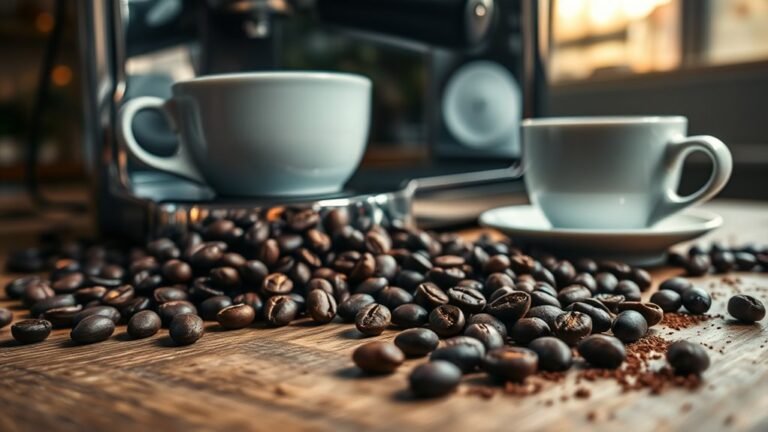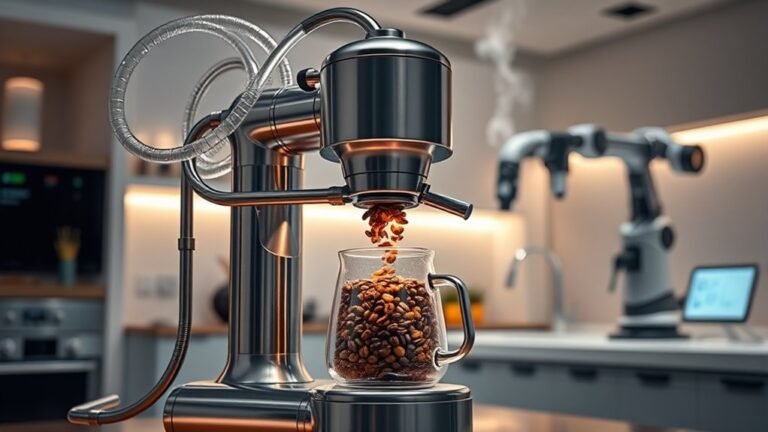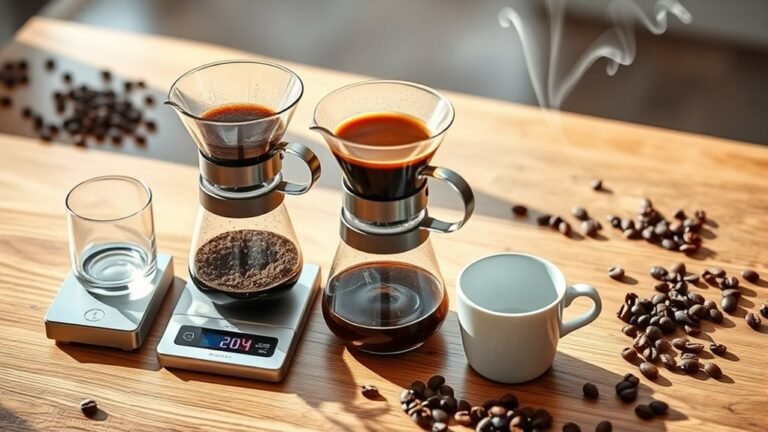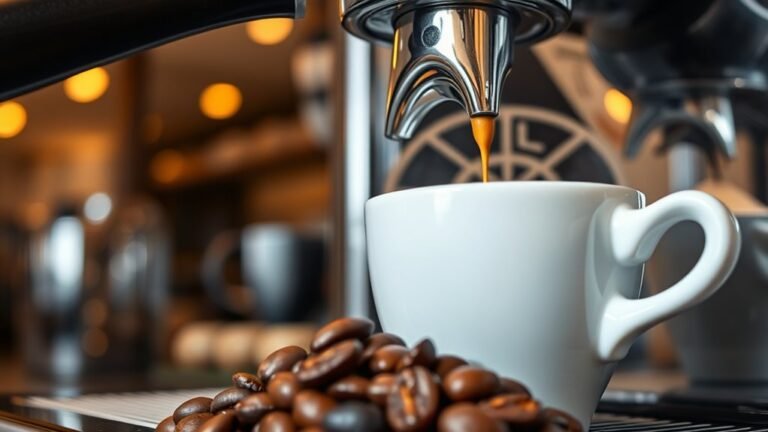Mastering the Pour-Over: A Step-by-Step Guide
To master the pour-over, start by selecting single-origin, light to medium roast beans for nuanced flavor. Use a quality dripper like Hario with a gooseneck kettle to control your pour precisely. Grind consistently to a medium-coarse size, aiming for even extraction. Heat water to about 200°F, then bloom your grounds for 30-45 seconds before pouring steadily to maintain saturation. Keep your brew time between 2:30 and 3:30 minutes to avoid bitterness or sourness. Explore each step closely to achieve café-level results.
Selecting the Right Coffee Beans

Although choosing the right coffee beans might seem straightforward, it’s essential to understand how origin, roast profile, and processing method impact your pour-over’s flavor clarity and complexity. Start by selecting single origin beans to fully experience distinct flavor profiles unique to specific regions, like Ethiopian floral notes or Colombian chocolate undertones. Opt for a light to medium roast to preserve those nuanced flavors and acidity, which enhance your pour-over’s brightness and clarity. Consider the processing method—washed beans typically yield cleaner, more vibrant cups, while natural processed beans add fruity complexity. By mastering these variables, you’re not just brewing coffee; you’re crafting an expressive cup that celebrates freedom in flavor exploration, revealing the full spectrum of aromas and tastes your chosen beans have to offer.
Understanding Your Equipment
Once you’ve chosen beans that highlight your preferred flavor notes, the next step is getting familiar with the tools that will bring those flavors to life. Understanding your equipment is essential, especially given the rich pour over history emphasizing precision and control. You’ll want a quality dripper—brands like Hario, Kalita, and Chemex dominate for their consistency and design. Each offers unique flow rates and extraction profiles, so pick one that aligns with your taste and brewing style. Don’t forget a gooseneck kettle; its precise pour control lets you manipulate bloom and extraction evenly. A reliable scale is a must, too, ensuring you measure coffee and water accurately for repeatable results. Mastering your gear gives you the freedom to craft a cup that truly expresses your coffee’s character.
Grinding Your Coffee to Perfection
Every grind size dramatically influences the extraction and flavor profile of your pour-over coffee, making it critical to dial in your burr grinder precisely. Start by selecting a medium-coarse grind—think sea salt texture—as a baseline. Grinding techniques matter: use consistent, steady burrs to avoid uneven particle sizes that lead to over or under-extraction. Avoid blade grinders; their inconsistent grind sizes compromise clarity and balance. Adjust grind sizes incrementally; finer grinds speed extraction but risk bitterness, while coarser grinds slow it, risking sourness. Test and tweak based on your desired freedom in flavor expression. Remember, your grinder’s calibration is your gateway to revealing nuanced aromatics and sweetness. Master these grinding techniques, and you’ll control every aspect of your brew’s character.
Preparing Your Pour-Over Setup

To set up your pour-over station, gather essential gear like a gooseneck kettle, a scale with timer, and a quality dripper with paper filters. Precision matters, so measure your coffee-to-water ratio carefully—typically 1:16 for balanced extraction. With everything in place, you’re ready to control flow rate and brew temperature for a flawless cup.
Essential Equipment Checklist
Five key pieces of equipment form the backbone of a precise pour-over setup, each playing an essential role in extracting the coffee’s nuanced flavors. To master your brew, guarantee you have:
- Coffee scales – Precision is king. Use a scale with a timer to measure coffee grounds and water accurately, guaranteeing repeatable results and control over extraction.
- Brewing vessels – Your go-to dripper and carafe should promote even flow and heat retention. Ceramic or glass vessels are preferred for consistent temperature.
- Kettle with a gooseneck spout – Control the flow rate and pour pattern, which directly impacts bloom and extraction uniformity.
With these essentials, you’re equipped to reveal freedom in crafting balanced, vibrant pour-overs tailored to your palate.
Ideal Coffee-to-Water Ratio
Once your equipment is dialed in, the next step is dialing the coffee-to-water ratio, which fundamentally shapes your brew’s strength and clarity. A standard starting point is 1:16—one gram of coffee per 16 grams of water—balancing extraction and body for a clean cup. Adjusting this ratio lets you customize coffee strength: increase the dose for a bolder profile, or add water for a lighter, more nuanced brew. Precision scales are essential here to guarantee brewing consistency, eliminating guesswork and enabling repeatable results. Remember, slight tweaks can dramatically affect flavor perception, so experiment within a narrow range. Mastering this ratio frees you to craft a pour-over tailored exactly to your taste, turning every cup into a deliberate expression of your preferred coffee character.
Heating the Water to Optimal Temperature

You’ll want to heat your water to between 195°F and 205°F to extract the perfect balance of flavors without scorching the grounds. Using a gooseneck kettle with precise temperature control is your best bet for consistent results. Avoid boiling water directly on the stove without monitoring, as even slight temperature swings can throw off your brew.
Ideal Temperature Range
Achieving the perfect extraction starts with heating your water to the ideal temperature range, typically between 195°F and 205°F (90°C to 96°C). This coffee temperature window is essential because it maximizes flavor solubility without causing over-extraction or bitterness. In brewing science, temperature directly affects how coffee compounds dissolve. To master this, consider these steps:
- Aim for 200°F (93°C) as a reliable midpoint for balanced extraction.
- Avoid temperatures below 195°F; they under-extract, leaving sour notes.
- Steer clear of exceeding 205°F, which extracts excessive bitterness and astringency.
Best Heating Methods
While precise temperature control is vital, selecting the right heating method guarantees your water reaches and maintains the ideal range for extraction without sacrificing consistency. Electric kettles with variable temperature settings provide you with precise control, allowing you to dial in between 195°F and 205°F effortlessly. If you prefer more manual control, induction cooktops offer rapid, even heating but require a reliable thermometer to avoid overshooting. Using a gooseneck electric kettle not only gives precision in pouring but assures water is heated to the perfect temperature before brew. Whichever method you choose, maintaining temperature stability during pouring is essential for extracting balanced flavors and revealing your coffee’s full potential. Embrace the freedom to experiment with these heating tools to elevate your pour-over game.
Blooming the Coffee Grounds

Before pouring the full amount of water, you want to wet the coffee grounds just enough to release carbon dioxide—this process is called blooming. Blooming techniques are essential for releasing coffee freshness, ensuring your cup’s flavor isn’t masked by trapped gases. Here’s how to master it:
- Pour twice the weight of coffee in water slowly over the grounds.
- Allow the bloom to develop for 30 to 45 seconds; you’ll notice bubbling and expansion.
- Use water heated between 195°F and 205°F to optimize solubility without scorching.
This controlled pre-infusion liberates trapped CO2, preventing uneven extraction and bitterness. Mastering the bloom means embracing the freedom to coax maximum flavor complexity from your beans, setting a solid foundation before the full pour.
Pouring Techniques for Even Extraction
With the bloom fully developed, you’re ready to pour the remaining water in a controlled manner to guarantee even extraction. Maintain a steady pouring angle around 45 degrees to assure a gentle flow that won’t disturb the coffee bed. Start pouring at the center, moving outward in a slow, consistent circular motion, evenly saturating all grounds. This method promotes uniform extraction by preventing channeling and dry spots. Avoid pouring directly on the filter to keep flow rates stable. Keep your pour steady and deliberate, adjusting speed to maintain the water level just above the grounds without flooding. Mastering this pouring technique gives you freedom to tailor extraction, releasing the full flavor potential of your beans with precision and consistency.
Timing Your Brew for Best Flavor
How long you let your coffee brew can make all the difference between a balanced cup and one that’s either under-extracted or bitterly overdone. Mastering the timing of your brew cycle is essential for ideal flavor extraction. Here’s how to dial it in:
- Start with a bloom phase of 30-45 seconds to release CO2 and prepare grounds for even saturation.
- Maintain a controlled pour over 2:30 to 3:30 minutes, adjusting grind size and pour rate to fine-tune extraction.
- Watch your total brew time; exceeding 4 minutes often leads to over-extraction, while under 2:30 risks sour, weak flavors.
Cleaning and Maintaining Your Equipment

Achieving the perfect extraction timing is only part of brewing outstanding pour-over coffee; keeping your gear spotless guarantees that every cup tastes as intended. Regular cleaning removes oils and mineral buildup, preserving your equipment lifespan and preventing off-flavors. Rinse your dripper and server immediately after use with hot water, and deep clean weekly using a coffee-specific detergent. Filters should be stored dry to avoid mold. Below is a maintenance checklist to keep you on track:
| Equipment | Cleaning Frequency |
|---|---|
| Dripper | After every brew |
| Server | After every brew |
| Grinder burrs | Weekly |
| Filters | Store dry, replace regularly |
| Cleaning detergent | Monthly deep clean |
Frequently Asked Questions
Can I Use Flavored Coffee Beans for Pour-Over Brewing?
Think of flavored beans as a canvas painted with bold strokes — they bring unique aromas but can overshadow subtle pour-over nuances. While you can use flavored beans, your brewing techniques need adjustment; pour-over emphasizes clarity and delicate extraction, which flavored beans might mask. If you crave freedom in flavor, experiment with grind size and water temperature to balance. Just remember, flavored beans may limit the classic pour-over’s clean, nuanced profile.
How Does Altitude Affect the Pour-Over Brewing Process?
At higher altitudes, water boils at lower temperatures, so you’ll need to adjust your brewing temperature to guarantee proper extraction. Since water saturation depends on temperature, cooler water may under-extract your grounds, leading to sour flavors. To compensate, try using slightly hotter water than usual and extend your brew time to achieve full saturation and balanced extraction. This way, you maintain control and freedom over your pour-over’s taste profile.
Is It Necessary to Use Filtered Water for Pour-Over Coffee?
You know what they say: “You can’t make a silk purse out of a sow’s ear.” For pour-over, water quality is vital. Using filtered water guarantees ideal extraction and prevents off-flavors, preserving your brew’s delicate notes. Plus, filtered water helps maintain consistent brewing temperature, essential for balanced extraction. So, if you want freedom in flavor exploration, always use filtered water—it’s the foundation for a clean, vibrant cup every time.
Can I Make Iced Coffee Using the Pour-Over Method?
Absolutely, you can make iced coffee using pour-over variations. One popular iced coffee technique is the Japanese-style cold brew: brew hot coffee directly over ice to chill it instantly, preserving vibrant flavors and aroma. Just use a slightly coarser grind and adjust your coffee-to-water ratio to prevent dilution. This method gives you crisp, invigorating coffee with full-bodied notes, perfect for those who want freedom from traditional hot brews without sacrificing quality.
What Are Common Mistakes to Avoid When Pouring Water?
You might think pouring water quickly extracts more flavor, but that’s a myth. To avoid bitterness or under-extraction, watch your pour rate—it should be steady and controlled. Also, water temperature is essential; too hot scalds the grounds, too cool yields weak coffee. Aim for 195-205°F and pour in slow, concentric circles. This precision lets you reveal complex flavors while giving you the freedom to tweak your brew to perfection.






